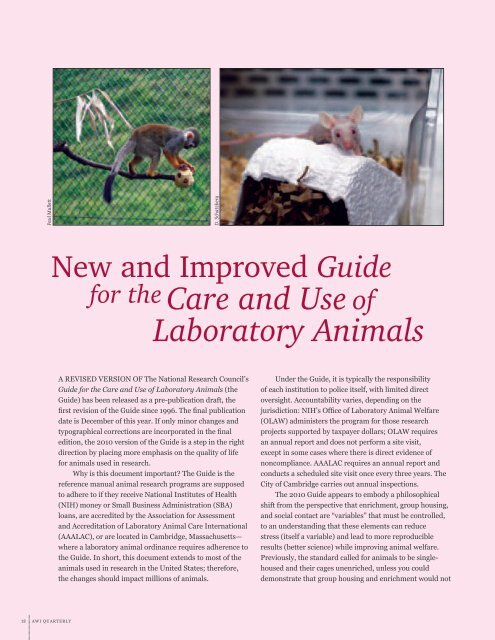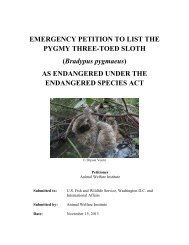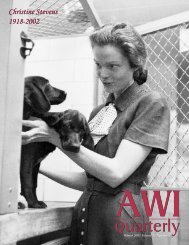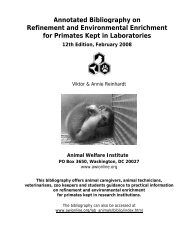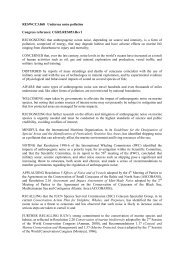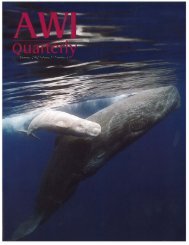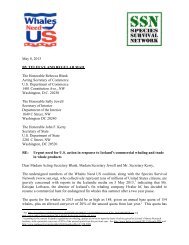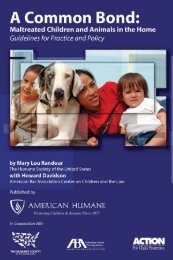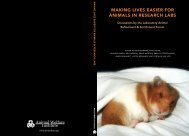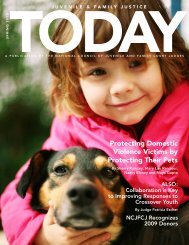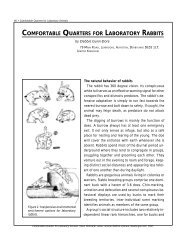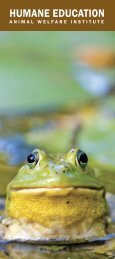Quarterly - Animal Welfare Institute
Quarterly - Animal Welfare Institute
Quarterly - Animal Welfare Institute
- No tags were found...
You also want an ePaper? Increase the reach of your titles
YUMPU automatically turns print PDFs into web optimized ePapers that Google loves.
Paul MullettNew and Improved Guidefor the Care and Use ofLaboratory <strong>Animal</strong>sA REVISED VERSION OF The National Research Council’sGuide for the Care and Use of Laboratory <strong>Animal</strong>s (theGuide) has been released as a pre-publication draft, thefirst revision of the Guide since 1996. The final publicationdate is December of this year. If only minor changes andtypographical corrections are incorporated in the finaledition, the 2010 version of the Guide is a step in the rightdirection by placing more emphasis on the quality of lifefor animals used in research.Why is this document important? The Guide is thereference manual animal research programs are supposedto adhere to if they receive National <strong>Institute</strong>s of Health(NIH) money or Small Business Administration (SBA)loans, are accredited by the Association for Assessmentand Accreditation of Laboratory <strong>Animal</strong> Care International(AAALAC), or are located in Cambridge, Massachusetts—where a laboratory animal ordinance requires adherence tothe Guide. In short, this document extends to most of theanimals used in research in the United States; therefore,the changes should impact millions of animals.D. SchatzbergUnder the Guide, it is typically the responsibilityof each institution to police itself, with limited directoversight. Accountability varies, depending on thejurisdiction: NIH's Office of Laboratory <strong>Animal</strong> <strong>Welfare</strong>(OLAW) administers the program for those researchprojects supported by taxpayer dollars; OLAW requiresan annual report and does not perform a site visit,except in some cases where there is direct evidence ofnoncompliance. AAALAC requires an annual report andconducts a scheduled site visit once every three years. TheCity of Cambridge carries out annual inspections.The 2010 Guide appears to embody a philosophicalshift from the perspective that enrichment, group housing,and social contact are “variables” that must be controlled,to an understanding that these elements can reducestress (itself a variable) and lead to more reproducibleresults (better science) while improving animal welfare.Previously, the standard called for animals to be singlehousedand their cages unenriched, unless you coulddemonstrate that group housing and enrichment would notnegatively impact scientific results. The standard set in theupdated Guide is that animals should be socially housedand their cages enriched. This change in emphasis shouldempower each institution’s Institutional <strong>Animal</strong> Care andUse Committee (IACUC) 1 and animal care staff to provideenrichment and social housing as standard housingconditions. Although the 2010 Guide states that facilities“should” rather than “must” use enrichment and socialhousing, it is unquestionably stronger in this regard thanthe 1996 edition. The following is a quote from the newGuide regarding the primary enclosure:All animals should be housed under conditions that providesufficient space as well as supplementary structures andresources required to meet physical, physiologic, andbehavioral needs. Environments that fail to meet theanimals’ needs may result in abnormal brain development,physiologic dysfunction and behavioral disorders (Garner2005; van Praag et al. 2000; Würbel 2001) that potentiallycompromise both animal well-being and scientific validity.The primary enclosure or space may need to be enriched toprevent such effects and improve animal well-being....An appropriate housing space or enclosure should alsoaccount for the animals’ social needs. Social animalsshould be housed in stable pairs or groups of compatibleindividuals unless they must be housed alone forexperimental reasons or because of social incompatibility....Structural adjustments are frequently requiredfor social housing (e.g., perches, visual barriers, refuges),and important resources (e.g., food, water, and shelter)should be provided in such a way that they cannot bemonopolized by dominant animals....The section on IACUC review of protocols is anotherarea where the 2010 Guide emphasizes animal well-being.Previous editions of the Guide focused on IACUC review ofwhat the project will do and what outcomes are expected.This edition has stated that the following additional itemsshould be considered in the protocol review:• Impact of the procedures performed on the animals’well-being;• Description and rationale for anticipated or selectedendpoints;• Criteria and process for timely intervention, removal ofanimals from a study, or euthanasia if painful or stressfuloutcomes are anticipated; andCreature comforts for these cats includegroup housing and carpeted perches.• Method of euthanasia or disposition of animal, includingplanning for care of long-lived species following studycompletion.The Guide goes on to state:While the responsibility for scientific merit reviewnormally lies outside the IACUC, the IACUC shouldevaluate scientific elements of the protocol as they relateto the welfare and use of the animals.When considering certain animal use protocols withthe potential for unrelieved pain and distress, the 2010Guide further delineates:…the IACUC is obliged to weigh the objectives of the studyagainst potential animal welfare concerns. By consideringopportunities for refinement, the use of appropriate nonanimalalternatives and the use of fewer animals, boththe institution and the Principal Investigator can begin toaddress their mutual obligations for humane animal careand use.Page 18, Left to Right: A squirrel monkeyengages in natural behavior by workingto obtain food from a complex feeder. Apaper hut and nesting materials provideenrichment for a nude mouse.1The Institutional <strong>Animal</strong> Care and Use Committee (IACUC) is a selfregulatingentity that, according to U.S. federal law, must be establishedby institutions that use animals for research or instructional purposes, tooversee and evaluate all aspects of the institution’s animal care and useprogram. For more information, see www.iacuc.org.Michele Cunneen18 AWI QUARTERLYFALL 2010 19


